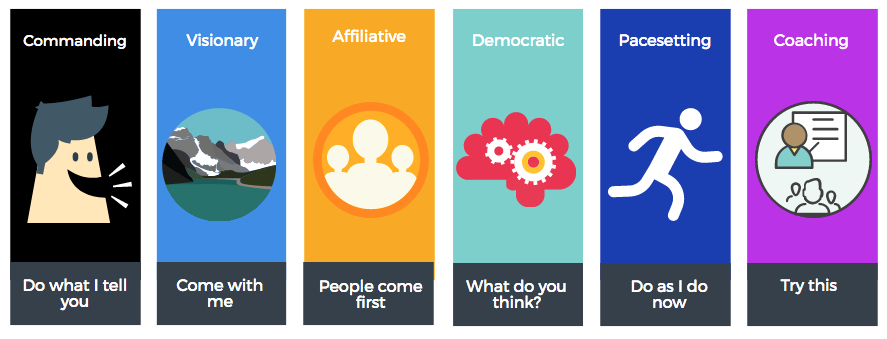
Is there a “one best way” of leading people?
In 1911, F.W. Taylor stated that there is not a “one best way” of organizing all the possible tasks, but each one should be analyzed and engineered to find ITS OWN best way of doing it, which may differ from one to another, thus creating Scientific Management.
We can take this as a starting point and similarly ask: is there a “one best way” of leading people? The answer, of course, is no, but there is a best leadership style for any given situation.
Thus, a leadership style should be intended as a tool, not only a personality trait.
Is there a “one best way” of leading people? The answer, of course, is no, but there is a best leadership style for any given situation.
Let’s take a closer look at leadership theories
There are many theories about leadership, all trying to define the traits of the excellent Leader according to different criteria. Based on what defines a good Leader, we can group them in macro-categories, and our learning design mainly relies on situational leadership, according to which a Leader should choose the best attitude and action plan based on the context within which he is operating.
In addition, we can identify three macro-styles of leadership according psychologist Kurt Lewin, who developed his framework in the 1930s, thus providing the foundation of many of the approaches that followed.
- Autocratic leadership consists of making decisions without consulting the team members, even if their input would be useful. This can be appropriate when you need to make decisions quickly, but can be demoralizing for the team.
- Democratic leadership includes team members in the decision-making process. This style is not suitable when a quick decision is needed, but generates satisfaction and high productivity.
- Laissez-faire is a style in which a Leader gives freedom on how to do the job and on the deadlines, while providing support and advice if needed. This autonomy can lead to high job satisfaction, but can be counterproductive if the team members lack the knowledge, skills or self-motivation to do their work effectively.
Some years later, Daniel Goleman, Richard Boyatzis, and Annie McKee described six distinct leadership styles that are nicely summarized in this graphic (source).

A good Leader is not always the same, but must be able to read the context and implement different styles of leadership according to it.
The importance of emotional intelligence
Before defining the best leadership style for each situation, we must point out that to apply situational leadership, emotional intelligence must be fundamentally understood and used, i.e., the ability to recognize our own emotions as well as the emotions and feeling of others, label them appropriately and use this information to guide our thinking, behavior and attitude.
According to a study performed by D. Goleman, “Executives who lacked emotional intelligence were rarely rated as outstanding in their annual performance reviews, and their divisions underperformed by an average of almost 20%”.
Thus, knowing and applying emotional intelligence is the first step to being a better Leader and to using situational leadership.
The model introduced by Goleman defines the emotional intelligence as a wide array of competencies:
- Self-awareness: the ability to recognize and label our emotions, values and goals, and identify their impact on others during our management activity
- Self-regulation: the ability to control our emotions and adapting to different scenarios
- Social skill: the ability to efficiently managing relationships to drive people to the goal
- Empathy: the ability to be in another person’s shoes, thus considering their feelings in our decision-making process
- Motivation: the ability to set and maintain a drive on the achievement of the goal
Goleman suggests that everybody is born “with a general emotional intelligence that determines his potential for learning emotional competencies”. In fact, emotional competencies can be learned by study and practice, which is also an important point at the basis of the SkillGym methodology.
By practicing in a safe environment specifically designed to train these aspects, every user can improve his emotional intelligence and related competencies, while applying the most suitable leadership style.
Each situation, its own style
In the next section, based on the different theoretical approaches, we will show the best leadership style to efficiently manage a situation that you could encounter in real life and in SkillGym’s Digital Role Plays.
Crisis situations
In crisis situations, when a fast change is needed or if a problem arises with an employees, a commanding, coercive leadership style is the most effective approach. This style often depends on orders, punishment and tight control.
It can have a negative effect on a team, so Leaders must know when to stop using it, usually immediately after the critical situation is over.
Typical aspects of the best leadership style in this context:
- Give lots of directives
- Rarely seek any input from the team
- Control tightly through constant monitoring
- Use negative feedback
- Motivates others by emphasizing the consequences of doing a bad job
This approach is most effective:
- When tasks are straightforward
- When the team needs clear direction and the Leader has more information than the collaborators
- When not doing it will result in serious consequences, such as safety and health issues
- With underperforming individuals when other strategies have failed
This approach will not work well in complex situations and with highly skilled team members.
Times of change
Situations in which a new direction is needed or a turnaround is on the way, are well managed with an authoritative, visionary leadership, since there is the need to inspire and motivate people toward a common goal. The Leader will tell them where they’re all going, but not how.
Empathy is the most important aspect here, but keep in mind that this style is less likely to be effective when you’re working with a team more experienced than you.
Typical aspects of the best leadership style in this context:
- High use of facilitation technique
- Individuals’ perspective on the vision is requested and considered
- Use of a wide array of methods (both positive and negative) to enhance tam’s motivation and performance
This approach is most effective when:
- A new vision or clear direction is needed
- The Leader believes in the vision
- The Leader is self-confident, self-aware and empathic to others
This approach will not work if the Leader is not viewed as credible by the team.
Conflict and stressful times
When the team is experiencing tension or conflict or in presence of trust problems, an affiliative style will help to promote harmony within the team. The Leader has to take in account the emotional needs of all the people and be positive.
Typical aspects of the best leadership style in this context:
- The Leader places more emphasis on the individuals than on the task
- The Leader shares his emotional challenges with the team members in an appropriate manner
- Correct behaviors and task delivery are rewarded
The approach is most effective when:
- The team requires direct assistance
- When used together with other leadership styles like coaching or visionary
- Team’s emotional needs and concerns are clear and shared
This approach will not work in complex situations where clear directions are needed, if the Leader lacks empathy and when the team or individual performance is weak.
Supporting growth
Whenever a collaborator needs coaching or mentoring to develop some skills in the medium term or there is a misalignment in behaviors, skills, etc., a coaching leadership style is suitable because it connects people’s personal goals with those of the organization.
A Leader using this style has to be empathic and focus on developing others. The coaching is usually expressed in having critical conversations, often informally, and has a positive impact because it’s motivating and helps to establish rapport and trust.
Typical aspects of the best leadership style in this context:
- The Leader helps the team member to identify their strengths and weaknesses with the context of their aspirations
- The coach/mentor provides on-going support, challenges and feedback
- In some contexts, it may trade off short-term performance for longer-term development
The approach is most effective when:
- The coachee acknowledges a gap between the “here and now” and where he would like to be
- Team members are motivated to take initiative, be innovative and take risks
This approach will not work in crisis situations, when there is no time to invest in longer-term development of individuals and when individuals are seeking direction and feedback.
Building harmony
When there is a need to onboard the collaborators on a new idea, build consensus and gather the input of the team, a democratic leadership that focuses on collaboration and listening is the best approach.
The Leader has to involve the team in problem solving and decision making, and eventually teach the members the skills they need.
Typical aspects of the best leadership style in this context:
- Team members are invited to make decisions affecting their own work
- Decisions are made by consensus
- Many meetings are held to gather team’s concerns
- Adequate performance is rewarded and negative feedback is rarely used
The approach is most effective when:
- The team members are competent
- There is enough time to manage the meetings
- Team members don’t have a passive attitude
This approach will not work in crisis situations, when there is a shortage of time and with people who are inexperienced or uninformed about a situation.
Getting good results
When the focus is on performance and goals and high standards are expected, the Leader should apply a pacesetting leadership style.
The Leader who chooses to rely on this style must learn how to improve the skills of the team using Kaizen techniques, train them properly and coach them whenever needed.
To maintain team motivation, it is advisable to share the vision and clear expectations.
Typical aspects of the best leadership style in this context:
- The Leader holds and exemplifies the high standards he requests of the team
- Asks the team to work faster and better
- Poor performers are pinpointed
The approach is most effective when:
- Team members are motivated and competent
- Team members need little direction or management
- Quick results are required
This approach will not work if team members have a strong need of vision, personal development and management or are poor performers. Using this style can have a negative effect on the team if overused or used for a long time since it can lead to burnout, exhaustion and high turnover.
Experimenting in a safe, virtual environment
Considering what we have said up to this point, we can conclude that a good Leader is not always the same, but must be able to read the context and implement different styles of leadership according to it.
The leadership in any context is expressed by words, attitudes and gestures. In fact, it’s within a situation that things, gestures, words and attitudes gain a meaning.
When providing soft skills training, role play is one of the most effective strategies because it allows learners to practice a difficult conversation in a protected environment, while having the opportunity to discuss outcomes and receive personalized feedback.
In this context, the situation that is depicted in the simulator is very important and is part of the training experience.
Carefully practicing on the most common and the most critical situations that can happen in real life helps to build confidence in the trainees and generates a “Deja-vu” effect in the most efficient way.
The dialogue between the user and the character of a SkillGym Digital Role Play takes place by selecting from a set of questions and answers that are designed to fit the most common communication styles and possible behaviors.
Each sentence represents one possible application of the requested skills and allows the conversation to flow according to one’s own style and topics. If the user would not use any of the three sentences presented, he is encouraged to select the one he feels is the closest to his style (more on SkillGym skill set in this article “8 Ways Your Skills Will Improve by Practicing on Digital Role Plays”).
Since the possible canvas of different situations to practice critical conversations is potentially endless, here at SkillGym, we decided to apply the Pareto rule -also known as the 80/20 rule- to define which specific topics or issues we would use in developing each new plot, thus efficiently selecting the most common and the most critical situations that could happen in real life.
Finally, it is common practice to aggregate skills or behaviors into broader classifications referred to competencies. Naturally, we also apply this practice at SkillGym.
You can read about our approach in detail in this article (“A Curriculum for Conversational Leadership”) about our Leadership Curriculum.
For the user to achieve the best possible outcome in managing the situation in the Digital Role Play based on the learning objectives, the most suitable leadership style (as theorized by Goleman in this theory about the six styles of leadership) must be chosen.
Would you like to try these different leadership style in a virtual environment? You can book a 1-hour discovery call here.
Bibliography
-
Gill, R, Theory and practice of leadership. London: SAGE Publications, 2011
-
Goleman, What Makes A Leader, best of Harvard Business Review 1998
-
Goleman, Leadership That Gets Results, Harvard Business Review Classics, 2011
-
Boyatzis, R., Goleman, D., & Rhee, K. (2000). Clustering Competence in Emotional Intelligence: Insights from the Emotional Competence Inventory (ECI). In R. Bar-On & J.D.A. Parker (eds.): Handbook of Emotional Intelligence (p. 343–362). San Francisco: Jossey-Bass.
-
Six Emotional Leadership Styles
-
Leadership Styles –Daniel Goleman et al
